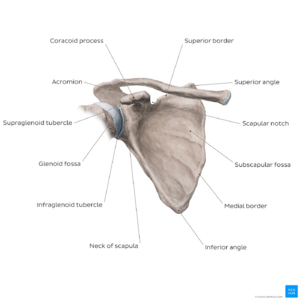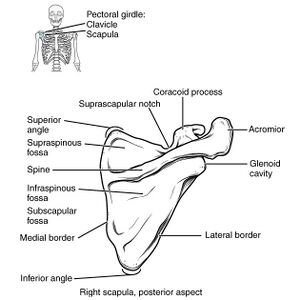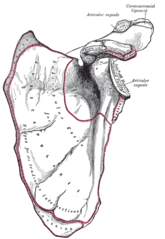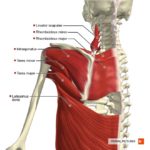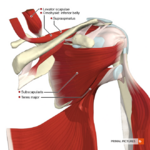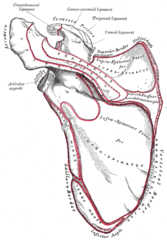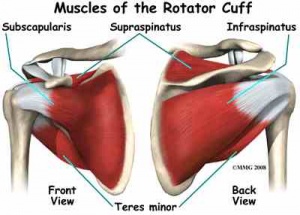Scapula
Original Editor - Venus Pagare
Top Contributors - Venus Pagare, Lucinda hampton, Kim Jackson, Uchechukwu Chukwuemeka, Chrysolite Jyothi Kommu, Joao Costa, Oyemi Sillo, Naomi O'Reilly, Vanessa Rhule and Ewa Jaraczewska
Introduction[edit | edit source]
The scapula is a thin, flat triangular-shaped bone placed on the postero-lateral aspect of the thoracic cage. It has 2 surfaces, 3 borders, 3 angles and 3 processes[1].
Osteology[edit | edit source]
The main part of the scapula, the body, consists of a somewhat triangular-shaped flat blade, with an inferiorly pointing apex, referred to as the inferior angle as well as lateral and superior angles. The scapula is described as having superior, medial, and lateral borders.
- Posteriorly, the scapula is divided into a supraspinous fossa and infraspinous fossa by the scapular spine. Anteriorly, on the costal surface, is the shallow subscapular fossa
- Laterally is the glenoid fossa.
- Anteriorly is the coracoid process
- Superiorly is the acromion that is continuous with the scapular spine and arcs anteriorly over the humeral head. The suprascapular notch lies immediately medial to the base of the coracoid process. The spinoglenoid notch lies posteriorly behind the neck.[2]
Angles
- Superior Angle is covered by trapezius
- Inferior angle is covered by the latissimus dorsi. It moves forwards round the chest, when the arm is abducted. Palpation of the inferior angle provides a convenient method for following the movement of the scapula during arm motion.
- Lateral or Glenoid angle is broad and bears the glenoid cavity or fossa, which is directed forward, laterally and slightly upwards.
Attachments on Scapula[edit | edit source]
The scapula's stability is dependent on the surrounding musculature, with several muscles that attach directly to the scapula. It has various bony projections for attachment of muscles, ligaments and other soft-tissue structures.[3] The levator scapulae attaches at the superior angle of the scapula, while the teres major attaches at the inferior angle of the scapula. The rhomboids major and minor attach to the medial border of the scapula, whereas the serratus anterior attaches to the medial margin. The subscapularis originates on the anterior surface of the scapula, also known as the subscapular fossa. The infraspinatus attaches to the posterior surface, also known as the infraspinous fossa. The superior portion of the posterior side is also known as the supraspinous fossa and the supraspinatus attaches here. The 4 rotator cuff muscles include the supraspinatus, infraspinatus, subscapularis, and teres minor. These 4 muscles form a musculotendinous cuff around the glenohumeral joint and provide muscular support to the joint.[4]
Muscles[edit | edit source]
17 muscles attach to the scapula!
- Subscapularis arises from the medial 2/3rds of the subscapular fossa.
- Supraspinatus arises from medial 2/3rds of supraspinous fossa including upper surface of the spine
- Infraspinatus arises from medial 2/3rds of infraspinous fossa, including lower surface of the spine.
- Deltoid arises from lower border of the crest of the spine and from lateral border acromion.
- Latissimus Dorsi lower fibres originate from inferior angle of the scapula
- Trapezius is inserted into the upper border of the crest of the spine and into medial border of the acromion.
- Serratus anterior is inserted along the medial border of costal surface; 1 digitation from the superior angle to the root of the spine, 2 digitations to the medial border, 5 digitations to the inferior angle.
- The long head of Biceps Brachii arises from supraglenoid tubercle and the short head from the lateral part of the tip of the coracoid process.
- Coracobrachialis arises from medial part of tip of the coracoids process
- Pectoralis minor is inserted into the medial border and superior surface of coracoids process.
- The long head of triceps arises from infraglenoid tubercle
- Teres minor arises from upper 2/3rds of rough strip on the dorsal surface along the lateral border.
- Teres major arises from lower 1/3rd of rough strip on the dorsal aspect of lateral border
- Levator scapulae is inserted along the dorsal aspect of the medial border, from superior angle up to root of the spine
- Rhomboideus minor is inserted into medial border (dorsal aspect) opposite to root of spine
- Rhomboideus major is inserted into the medial border (dorsal aspect) between the root of spine and inferior angle
- Inferior belly of omohyoid arises from upper border near the suprascapular notch.
Ligaments[edit | edit source]
- The margin of glenoid cavity gives attachment to the capsule of shoulder joint and to the glenoid labrum
- The margin of the facet on the medial aspect of the acromion gives attachment to the capsule of the acromioclavicular joint
- The coracoacromial ligament is attached to the lateral border of the coracoid process and to the medial side of the tip of the acromion process
- The coracohumeral ligament is attached to the root of the coracoids process.
- The coracoclavicular ligament is attached to the coracoid process; the trapezoid part on the superior aspect, and the conoid part near the root. The coracoclavicular ligament is made up of 2 bands: the conoid and the trapezoid, both of which provide vertical stability. The coracoacromial ligament connects the coracoid process to the acromion.
- The suprascapular ligament bridges across the suprascapular notch and converts it into a foramen which transmits the suprascapular nerve. The suprascapular ligament lie above the ligament.
- The spinoglenoid ligament bridges the spinoglenoid notch. The suprascapular vessels and nerve pass to it.
- The acromioclavicular ligament connects the distal end of the clavicle to the acromion and provides horizontal stability
Bursae[edit | edit source]
There are two major bursae:
- Scapulothoracic Bursa, between the serratus and the thorax, and
- Subscapularis Bursa, between the subscapularis and the serratus.
Biomechanics[edit | edit source]
The scapula upwardly rotates in the frontal plane, posteriorly tilts in the parasagittal plane, and externally rotates in the transverse plane during functional elevation. Scapular control is essential to scapulohumeral coordination. Posterior tilting is responsible for humeral clearance during the acromiohumeral portion of shoulder elevation.
Scapula articulates with the posterior chest wall and is alone in conjunction with the upper limb by the acromioclavicular joint. The acromioclavicular joint has no distinct movements and is only associated with movements by the scapulothoracic joint. The scapulothoracic joint movement is dependent on the acromioclavicular and sternoclavicular joints. The scapulohumeral rhythm is a combination of motions of the scapula, clavicle, and humerus to get full elevation of the arm, which has a 2:1 ratio. This means for every two degrees of movement at the humerus, the scapula moves one degree. To get the full 180 degrees of elevation of the arm, 120 degrees of movement occur at the glenohumeral joint, while 60 degrees of upward rotation occurs at the scapulothoracic joint. The scapula must upwardly rotate, posteriorly tilt and externally rotate, while the clavicle must elevate, retract and posteriorly roll. The thoracic spine must extend. The muscle synergists for upward rotation are the upper and lower trapezius and the serratus anterior.
A study reported that scapular upward rotation and retraction are greatest during abduction elevation, when compared to flexion elevation. They also discovered that posterior tilting was greatest during flexion elevation.[5] Any disturbance in this rhythm can decrease scapulothoracic movement and can be associated with fatigue, impingement, instability, and limits in elevation. [3] [6]
Resources[edit | edit source]
Watch this 3 minute video for a recap
Related pathology[edit | edit source]
- Scapular Dyskinesia
- Winged scapula
- Bankart lesion
- acromioclavicular joint injury
- osteochondroma
- giant cell tumour
- chondrosarcoma
- osteosarcoma
- Ewing's sarcoma
- multiple myeloma[2]
References[edit | edit source]
- ↑ The Skeletal System. Scapula. 2021 Available from: https://www.theskeletalsystem.net/arm-bones/scapula.html. (accessed August 16 2023).
- ↑ 2.0 2.1 Radiopedia Scapula Available from:https://radiopaedia.org/articles/scapula (accessed August16 2023).
- ↑ 3.0 3.1 Williams GR Jr, Shakil M, Klimkiewicz J, Iannotti JP. Anatomy of the Scapulothoracic Articulation. Clin Orthop Relat Res. 1999; 359:237-246.doi: 10.1097/00003086-199902000-00027.
- ↑ Merolla G, Cerciello S, Paladini P, Porcellini G. Snapping scapula syndrome: current concepts review in conservative and surgical treatment. Muscles, ligaments and tendons journal. 2013; 3(2): 80–90.
- ↑ Fung M, Kato S, Barrance PJ, Elias JJ, McFarland EG, Nobuhara K, et al. Scapular and clavicular kinematics during humeral elevation: a study with cadavers. J Shoulder Elbow Surg. 2001; 10 (3):278-85
- ↑ Culham E, Peat M. Functional Anatomy of the Shoulder Complex. J Orthop Sports Phys Ther. 1993;18(1):342-50.
- ↑ KenHub. Anatomy and function of the scapula. Available from: http://www.youtube.com/watch?v=fEXrPsGySKI [last accessed 16/8/2023]
